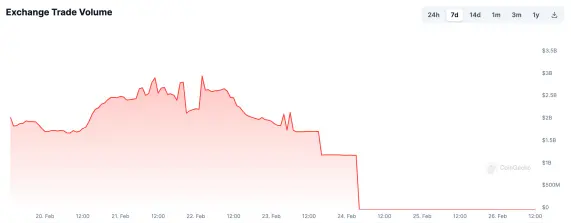Withdrawing funds and fleeing, another Hong Kong crypto exchange plays the "empty city strategy."
Written by: Tuo Luo Finance

As we all know, after the JPEX and HOUNAX fraud cases, Hong Kong has been very cautious in regulating virtual asset trading platforms, covering everything from information disclosure to advertising, giving a sense of "once bitten, twice shy," and doing everything possible to protect investors' interests.
However, those in the industry know that prevention is not as effective as mitigation. Without an increase in public awareness, fraudulent exchanges will continue to proliferate, and in the crypto circle where phishing links, familiar pyramid schemes, and account hacking are everywhere, running away with funds is not uncommon.
Recently, another trading platform successfully defrauded investors in Hong Kong, performing a "empty city strategy." This time, the operation was even more outrageous, taking the money and running without a word. On February 23, the crypto exchange BitForex, claiming to be headquartered in Hong Kong, disappeared from public view after withdrawing nearly $57 million from its hot wallet, leaving users unable to log in to their accounts.
This time, the regulatory authorities seem to be one step too late.
01 BitForex takes the money and runs, leaving an empty building
On February 23, the Hong Kong-based crypto exchange BitForex suddenly suspended withdrawals, claiming that wallet and website maintenance was causing delays in user withdrawals. At the same time, on-chain detective ZachXBT detected that before the exchange stopped processing transactions, approximately $56.5 million in cryptocurrency flowed out of three BitForex hot wallets.
On February 26, the exchange's website was officially shut down. Users could not log into their accounts or load the webpage, and began seeking help on social media. However, BitForex's X platform account had not been updated since February 21, and multiple users reported on its official Telegram channel that they could not access their accounts, and the dashboard showed no assets. The group has 23,413 members, with over 1,000 users online waiting for a response from the exchange. According to rumors, one of the administrators of the BitForex Telegram channel, Hazel_BitForex, has deleted her personal account.

BitForex's official website is no longer accessible, image source: BitForex official website
Although the official website is inaccessible, many public details can still be found on LinkedIn. BitForex claims to be headquartered in Hong Kong, with 6 million registered users and 51-200 employees, and has teams in Germany, Estonia, Singapore, Malaysia, the Philippines, and other countries. According to information from the Hong Kong Companies Registry, the company was registered in 2018 in the Kwai Chung area of the New Territories in Hong Kong. In fact, it was previously active in mainland China under the name "Bifu Network" before retreating overseas due to regulatory issues. The company's press releases also listed several related business locations. However, from the business locations, the ultimate fact is simply four words—an empty building.
To illustrate this, I refer to the report by DL News's Hong Kong correspondent Callan Quinn, who visited the registered and business locations. Unlike crypto companies that are densely registered in the city center or clustered in science parks and cyberports, this company is located about 40 minutes from the city center at the end of the Tsuen Wan Line, in the Dalianpai Industrial Area near the residential area of Kwai Fong.

The registered location of BitForex, image source: Callan Quinn
According to staff at the registered location, the company mainly provides virtual addresses for mainland Chinese companies aiming to establish offices in Hong Kong, having served thousands of businesses, as stated on the company website, with BitForex being just one of them. BitForex also listed the address of its company secretary at another location—a D/3 apartment building on the second floor of an industrial complex, where there was also no one present.
The last relevant location is in the relatively bustling Mong Kok. Although it was difficult to enter due to the absence of residents, letters and packages scattered at the entrance of the office building corresponded to different company names, suggesting that this address is merely one of the virtual address services. Google Maps corroborated this fact, showing that more than just BitForex uses this address.
The addresses are all fake, and the hundreds of claimed staff have long since vanished, undoubtedly indicating a premeditated scam. The suspension of withdrawals occurred a month after the platform's CEO Jason Luo left, leading users to believe this was the beginning of a money grab, as documents show Jason was the company's sole shareholder and director, currently residing in Shenzhen.
In fact, regardless of the fraudulent methods, this platform is not the first to encounter problems; multiple financial regulatory agencies have issued warnings against it. As early as October 2020, Malaysia's Securities Commission (SC) listed BitForex on its unauthorized warning list. In April 2023, Japan's Financial Services Agency (FSA) accused BitForex of violating the country's fund settlement laws, and the UK's Financial Conduct Authority also disclosed that BitForex had been operating in the country without registration.
However, this did not seem to affect the platform's operations. After exiting the aforementioned regions, in September 2023, BitForex claimed to be one of the leading cryptocurrency exchanges by market capitalization, with a daily trading volume of about $2.6 billion. According to CoinGecko data, the exchange's trading volume dropped from $2.5 billion to $1 billion between February 22 and 24. Currently, no data agency is tracking the platform, but interestingly, as early as 2019, BitForex was exposed by Chainalysis for falsifying trading data, indicating that the platform's real liquidity was only 1/800 of its reported trading volume, a staggering level of fraud.

BitForex's trading volume has rapidly declined, source: CoinGecko
02 Overseas groups involved, clues abound, the Securities and Futures Commission finally issues a statement
Regulatory response has once again been slow.
On March 4, after more than a week of suspended withdrawals, the Hong Kong Securities and Futures Commission (SFC) issued a public notice warning the public to beware of a virtual asset trading platform claiming to operate under the name BitForex, which is suspected of virtual asset fraud. BitForex has not been licensed by the SFC and has not applied for a license to operate a virtual asset trading platform in Hong Kong, and the SFC has listed it on its warning list of suspicious virtual asset trading platforms.
At the same time, the Hong Kong SFC once again warned investors to be cautious of the risks of trading virtual assets on unregulated platforms. If a platform ceases operations, goes bankrupt, is hacked, or experiences any misappropriation of assets, investors may lose all their investments held on that platform.

Suspicious platforms listed by the Hong Kong SFC, source: Hong Kong SFC
However, prior to this, the SFC had listed 14 suspicious virtual asset trading platforms, and BitForex was not among them. On February 29, the SFC announced the deadline for virtual asset trading platform license applications, with 21 platforms submitting application materials. According to regulations, exchanges that did not apply for a license by that date must cease operations in Hong Kong by May 31, 2024, and operating without a license is a criminal offense. Perhaps this was the last straw that broke BitForex.
Compared to previous scams targeting Hong Kong residents, this time the disappearance of the trading platform seems to involve more overseas groups, with many overseas individuals initiating victim Telegram groups for condemnation and tracking. Further investigation reveals that the token OMI has been frequently mentioned.

Many overseas OMI holders inquire about BitForex on the X platform, source: X platform
According to the official website, OMI is the ecosystem token of ECOMI, a trading platform based on blockchain NFTs and digital collectibles. This token is only listed on four trading platforms: OKX, BitForex, Gate, and AscendEx, with BitForex being the primary hub, holding 7% of the total supply of OMI. Therefore, the exit of this exchange significantly impacts some OMI holders, and the pursuit of accountability on the X platform has been particularly intense. However, from the price perspective, the token does not seem to have been affected, currently priced at $0.001083, up 29.20% in the past week, though compared to its peak of $0.008, it has clearly dropped significantly.
After the incident, ECOMI's official account on the X platform immediately responded, stating that they had begun attempts to contact local authorities and actively reach out to the exchange, but had no updates to provide. In response, some holders believe that the organization may have some connection to the exchange, as it has placed most of its market value and ecosystem on BitForex, while others claim that authorities are intervening to investigate, as OMI-related projects closed their Telegram groups and made personnel adjustments after the incident. However, from the current information, there seems to be no direct evidence linking the organization to the exchange's exit, and the SFC has not mentioned any related projects.
Coincidentally, a Hong Kong exchange, Atom Asset (AAX), which had already closed in 2022, has recently taken action. According to tracking by the Beosin team, after 426 days of silence, the AAX exchange wallet began to move, transferring large amounts of funds totaling $74 million to other addresses in batches, attempting to evade AML tools' detection and monitoring. AAX was once one of Hong Kong's largest crypto exchanges, and although former CEO Thor Chan and board member Liang Haoming were arrested by Hong Kong police in 2022 for fraud, its founder remains unidentified and is on the run with user funds worth HKD 230 million (approximately USD 29.41 million) and the private keys to access the exchange's wallet. Due to the coincidence of the incidents, some speculate that the founders of the two exchanges may be connected, but this is mostly conjecture without substantial evidence.
03 Is it a regulatory issue? Or the worst outcome?
The occurrence of these events has once again put crypto and the SFC in the spotlight.
However, from the facts, Hong Kong is already a global leader in financial regulation, and regarding crypto regulation, due to the stringent licensing requirements and limitations on investable cryptocurrencies, Asia Weekly has even published an article stating that Hong Kong's overly conservative regulation hinders innovation and flexibility.
Furthermore, as a securities regulatory body, the SFC is inherently limited in its ability to intervene before fraud occurs; it does not have such authority and can only issue warnings in the form of statements after receiving complaints or cooperate with police actions. As a globally renowned financial hub, Hong Kong's excellent and open business environment attracts many offshore institutions to register here, making it as difficult to investigate each one as finding a needle in a haystack. From another perspective, the public's understanding of the crypto field in Hong Kong is evidently insufficient; a trading platform with numerous past offenses claims to have 6 million customers, and regardless of the truth of this data, it is hard to believe. Perhaps it is precisely due to the information gap that this scam has ensnared many overseas groups.
Of course, this is not to say that the SFC bears no responsibility. A suspicious exchange has been operating for nearly six years, during which multiple institutions have reported on it and other regional financial regulators have issued statements, yet the regulatory body has remained unresponsive, reflecting Hong Kong's excessive tolerance and regulatory neglect.
In terms of impact, this platform incident is far less significant than JPEX, and how the follow-up handling will unfold remains difficult to track. Whether the new founders can be located and whether the embezzled funds can be recovered are still full of uncertainties. The worst outcome may just be another unsolved case, along with investors who have learned a bloody lesson from reality.











